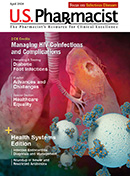US Pharm. 2011;36(5):21-22.
Inflammation of Pads Cushioning a Joint
Bursae are soft, fluid-filled sacs that surround the bones, muscles, and tendons of joints. These sacs may become inflamed as a result of pressure, trauma, or repetitive movement. When bursae are inflamed, the result is a painful condition known as bursitis.Bursitis can occur in any joint, but the elbows, shoulders, knees, and hips are the most likely locations. Leaning or kneeling on a hard surface may lead to pressure trauma in the elbows or knees; the shoulders may suffer repeated stress from motions in which the arms are lifted above the head. Sitting on a hard surface for a long period of time may cause bursae in the hip joints to become inflamed.
The primary symptoms of bursitis are pain and stiffness in the affected joint. The joint may appear red or swollen. In some cases, bursal inflammation is due to an infection. Bursitis is more likely to develop in people with osteoarthritis, rheumatoid arthritis, thyroid disease, diabetes, or gout.
Prompt treatment of an acute bout of bursitis is important in order to avoid chronic joint inflammation or flare-ups. Therapy includes rest, elevation, and immobilization of the affected joint. Ice may be used to reduce the inflammation in acute cases of bursitis, but it usually is not helpful for chronic cases. Oral or topical nonsteroidal anti-inflammatory drugs may be used to ease the inflammation and pain. Steroid injections may be indicated in cases that do not improve with these treatments.
If treated promptly, acute bursitis usually improves over a period of weeks. Steps to prevent future bouts of the disorder include avoiding repetitive movements, relieving pressure on elbow and knee joints, and avoiding prolonged sitting on hard surfaces. Frequent breaks should be taken while performing any activity that could cause a flare-up.
Typically Caused by Joint Overuse or Repetitive Movements
Bursitis, a type of inflammation, is relatively common, especially during middle age. This inflammation is typically caused by overuse of a joint over a short time period or by repetitive movements over a longer period. Although it rarely is serious, inflammation of the bursae (fluid-filled sacs cushioning a joint’s bones, muscles, and tendons) can be painful in the short term and debilitating if it develops into a chronic condition. Bursitis most frequently affects the elbows, shoulders, knees, and hips, but it also may occur in the heel or big toe.
Causes
The most common causes of bursitis are pressure and repetitive trauma. People at highest risk for bursitis are those in middle age with chronic diseases such as osteoarthritis, rheumatoid arthritis, gout, thyroid disease, or diabetes. Occupations that require repetitive movements, such as playing a musical instrument, gardening, laying flooring, carpentry, or throwing a baseball, may lead to bursitis. A less common cause of bursitis is infection, which also may be responsible for the joint inflammation and pain.
Diagnosis
There is no specific test to confirm a diagnosis of bursitis. Most often, diagnosis is made after a physical examination is performed and a thorough history is taken of any pertinent injuries or work-related activity. The type of pain (sharp, dull, constant, intermittent) and which types of movements worsen or improve the pain are important clues for diagnosis.
Standard x-rays are not helpful for confirming the diagnosis, but they may be used to rule out other conditions that might cause similar joint pain. MRI may be used to visualize inflammation in a joint. An infection or gout in the bursa may be suspected if the joint is red, warm, and swollen; in this case, a blood test can help determine whether an antibiotic or gout medication is appropriate. If the bursa requires drainage, the fluid is examined for the presence of infection or uric acid crystals. This information will help guide the decision to use antibiotics or gout medication to treat the inflammation.
Treatment
Therapy for bursitis includes rest and immobilization; elevation of the affected joint may be appropriate as well. Restricting movement of the affected joint permits it to heal more rapidly. In the case of recent-onset bursitis, cold packs may be applied three or four times daily for 20 to 30 minutes to help ease inflammation. Prescription or OTC oral nonsteroidal anti-inflammatory drugs (NSAIDs) such as ibuprofen also may help reduce inflammation. Prescription diclofenate, another NSAID that is available for topical use in a solution, gel, or patch applied to the skin, may also relieve the pain of bursitis.
If these measures do not provide relief, injection of a corticosteroid into the space around the inflamed area in the joint may be helpful. If infection is present, antibiotic therapy is appropriate. If gouty crystals are the cause of inflammation, gout medication may be prescribed.
Most cases of acute bursitis improve with rest and the use of NSAIDs. If you have questions about medications used to treat bursitis, your pharmacist can help.





